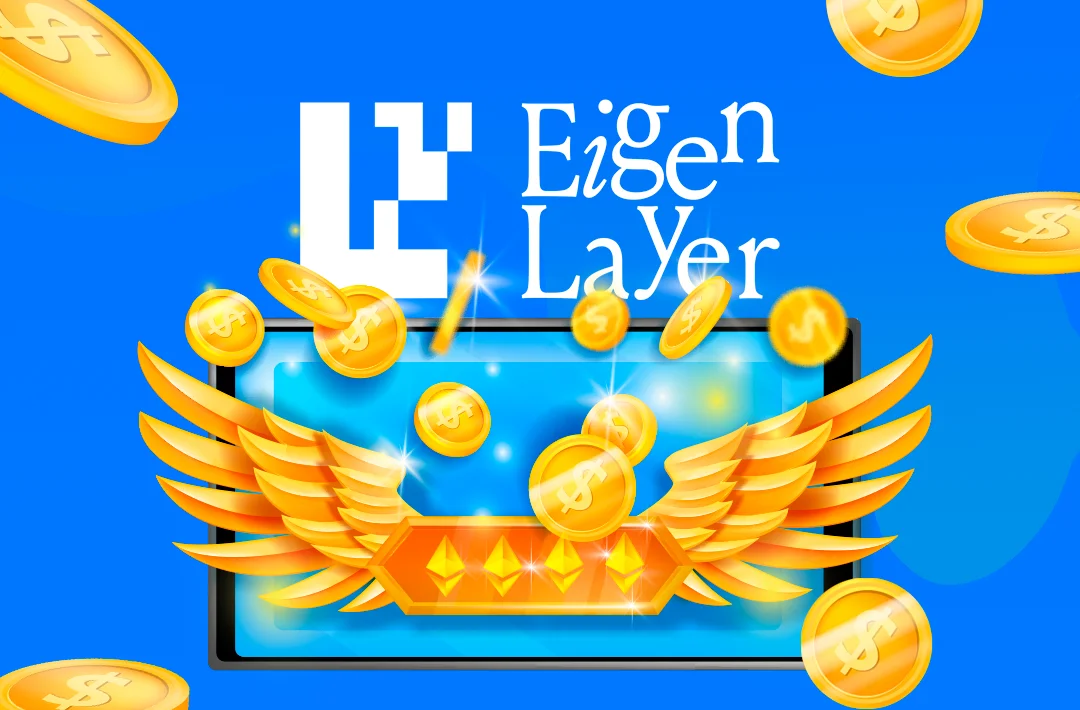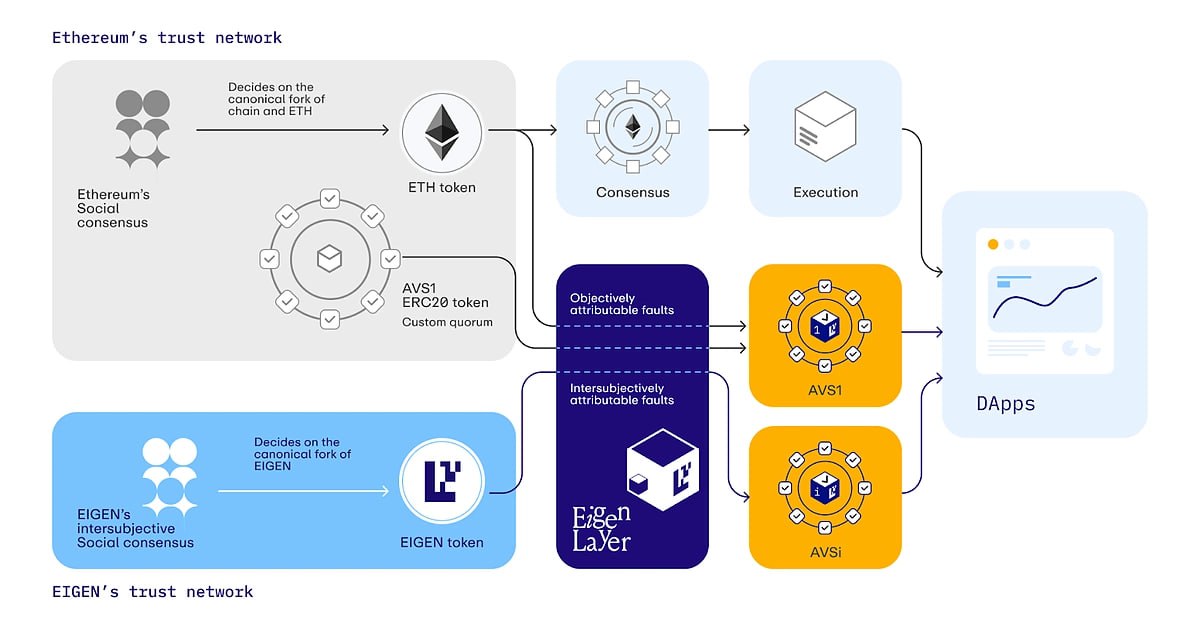EigenLayer: what is it and how does decentralized restaking work?
We explain how you can use ETH in staking to generate additional income

16.08.2024
983
8 min
0
The Ethereum blockchain switched to the Proof-of-Stake (PoS) consensus algorithm back in 2022. The concept of staking replaced the mining of native ETH coins, opening up new opportunities for rewards for participating in keeping the mainnet secure. But the ecosystem’s development did not end there: Sreeram Kannan, an assistant professor at the University of Washington in Seattle, created the EigenLayer protocol, which has become one of the newest tools.
Content:
- What is EigenLayer?
- What is restaking?
- How does EigenLayer work?
- How can one make money from restaking?
- Tokenomics and investing
- Advantages and disadvantages
- Conclusions
What is EigenLayer
EigenLayer is a protocol built on the Ethereum network that utilizes the new concept of “redistribution” to extend the security and utility of the network to other projects in the industry. With EigenLayer, security infrastructures are improved across the Ethereum network without requiring stakers to invest more. This means that decentralized applications (dApps) can apply their already staked tokens when using EigenLayer, instead of staking new assets. This method eliminates fragmentation and leads to a unified and more secure ecosystem.
| Protocol name | EigenLayer |
| Community website | https://www.blog.eigenlayer.xyz |
| Developer website | https://www.eigenlayer.xyz |
| Link to X | https://twitter.com/eigenlayer |
| Link to Discord | https://discord.com/invite/eigenlayer |
| Native token | EIGEN |
What is restaking?
Restaking is an innovative mechanism that allows validators to re-place their locked cryptocurrency on multiple services simultaneously based on a PoS algorithm. This means that the same staked assets can be protected by multiple platforms, expanding their utility and increasing rewards for holders. EigenLayer offers precisely the structure through which restaking is possible.
How does EigenLayer work?
EigenLayer’s architecture consists of key components that make its services run smoothly. These include:
- Restakers. Participants that provide overall security through Ethereum and function as a pillar of EigenLayer.
- AVS (Actively Validated Services). They offer innovative use cases for assets, focusing on the benefits of Ethereum’s overall security.
- Rollups. Rely on services provided by AVS, such as hyper-scalable data availability supported by the EigenLayer ecosystem.
- Operators. They perform validation tasks for AVS.
It is important to note that in the EigenLayer protocol provides users and validators with a free security market. This allows validators to decide whether to participate in each module built on EigenLayer. This allows for flexible market management and the ability to introduce new features as new blockchain modules with the optimal combination of security and performance parameters emerge.
How can one make money from restaking with EigenLayer?
Earning rewards through EigenLayer is based on participating in a new method of restaking. Below is a step-by-step guide on how to take advantage of this opportunity:
- First, you need to buy ETH and stake it in one of the compatible protocols.
- Then you should convert ETH into synthetic one. This can be stETH, rETH, or cbETH.
- Afterward, you need to deposit the asset into the open EigenLayer pools. The project’s team announces their opening, so it is worth following the publications on one of the social networks.
- Restaking assets with EigenLayer will bring additional rewards in the form of EIGEN tokens.
- It is important to regularly monitor the results of restaking and manage your assets based on updates and changes in the network.
Tokenomics and investing
The EigenLayer protocol has its own utility token, EIGEN, which was designed as an important part of restaking and validation processes. The token is created on the Ethereum blockchain, and one of its tasks is to stimulate and reward validators.
EIGEN has also become a key element in the EigenLayer protocol management system. Holders of these tokens can make suggestions and participate in voting on protocol upgrades and changes, thus providing a decentralized management process that is controlled by the community.

At the time of the project’s launch, the number of EIGEN was 1 673 646 668. The distribution was planned as follows:
Community (45%): 753 141 000 tokens are earmarked to support community initiatives, Ethereum issuance, and ecosystem expansion.
Investors (29,5%): 493 725 767 tokens are set aside for project investors, with a 12-month freeze clause, followed by a linear monthly distribution over 24 months after the token generation event (TGE).
Early investors (25,5%): 426 779 900 tokens distributed to early investors according to the same schedule as the investors.
The EigenLayer project was able to raise significant funds through several funding rounds:
In August 2022, $14,5 million was raised from Polychain Capital, Ethereal Ventures, and others. A Series A round in March 2023 helped raise $50 million at a $500 million valuation, with investors including Blockchain Capital and Coinbase Ventures. And in a seed round in February 2024, EigenLayer received $100 million from Andreessen Horowitz (a16z).
This financial backing shows a lot of confidence in EigenLayer as a promising and innovative player in the field of decentralized finance.
According to DeFiLlama, as of August 2024, the total value locked (TVL) of assets in the liquid restaking protocol reached $12,83 billion. This figure rose sharply in December 2023 and then in February 2024. The maximum was set at the beginning of June 2024: at that time TVL was $20,1 billion. According to this indicator, the EigenLayer project ranks second in the Ethereum ecosystem.
Advantages and disadvantages
The EigenLayer protocol has undeniable advantages:
- Increased dApps security. The use of a pool of validators in various EigenLayer modules helps to improve the overall security of decentralized applications that rely on these modules. This, in turn, increases trust among users interacting with dApps.
- Test environment. EigenLayer serves as a platform for testing and verifying new Ethereum features before implementing them on the mainnet. In such an environment, developers can realize experiment with new ideas.
- Access to innovation. Developers no longer need to create their own validator sets to secure applications. They can leverage EigenLayer’s existing pool of verified validators through restaking. This simplifies entry for developers and facilitates the growth of innovative solutions in the Ethereum ecosystem.

Media: Lido founders and investors secretly back EigenLayer competitor
The new Symbiotic protocol will be able to support ERC20 standard assets, unlike EigenLayer
The disadvantages include the following:
- Complexity. EigenLayer introduces an additional layer of complexity to the Ethereum ecosystem. Some users may find it difficult to understand the mechanics of restaking, selecting the necessary modules, or dealing with technicalities (especially for solo-stakers).
- Centralization threats. Although EigenLayer increases the level of trust in a decentralized environment, there may be a situation where certain staking pools become dominant, leading to some centralization within collective restaking.
- Risks of collusion between modules. EigenLayer’s modular architecture provides flexibility, but it also poses potential risks of forming arrangements between malicious attackers who would seize control of multiple modules at the same time.
Conclusions
The EigenLayer protocol is a flexible and scalable solution aimed at improving the security and performance of the Ethereum blockchain. Its innovative approach to restaking and the formation of a competitive market for federated security create significant benefits for both validators and decentralized applications.
The outlook and project are promising: as EigenLayer evolves and grows in popularity, it forms the potential to become a key element of the Ethereum ecosystem, fostering innovation and opening up additional opportunities for monetization and increased network security. Participation in EigenLayer allows you to maximize the use of staking assets and contribute to a more secure and efficient blockchain environment.
Useful material?
Basics
Why Satoshi Nakamoto’s technical manifesto for a decentralized money system matters
Oct 31, 2022
Basics
Experts evaluated the development prospects of the new ecosystem and the investment attractiveness of its token
Oct 20, 2022
Basics
How to track fluctuations correctly and create an effective income strategy
Sep 13, 2022
Basics
Review of the most profitable offers from proven trading platforms
Aug 29, 2022
Basics
The Ethereum Foundation team has published a breakdown of major misconceptions about the upcoming network upgrade
Aug 18, 2022
Basics
What benefits the exchange offers, and what else is in the near future
Aug 4, 2022









 Telegram
Telegram  Twitter
Twitter